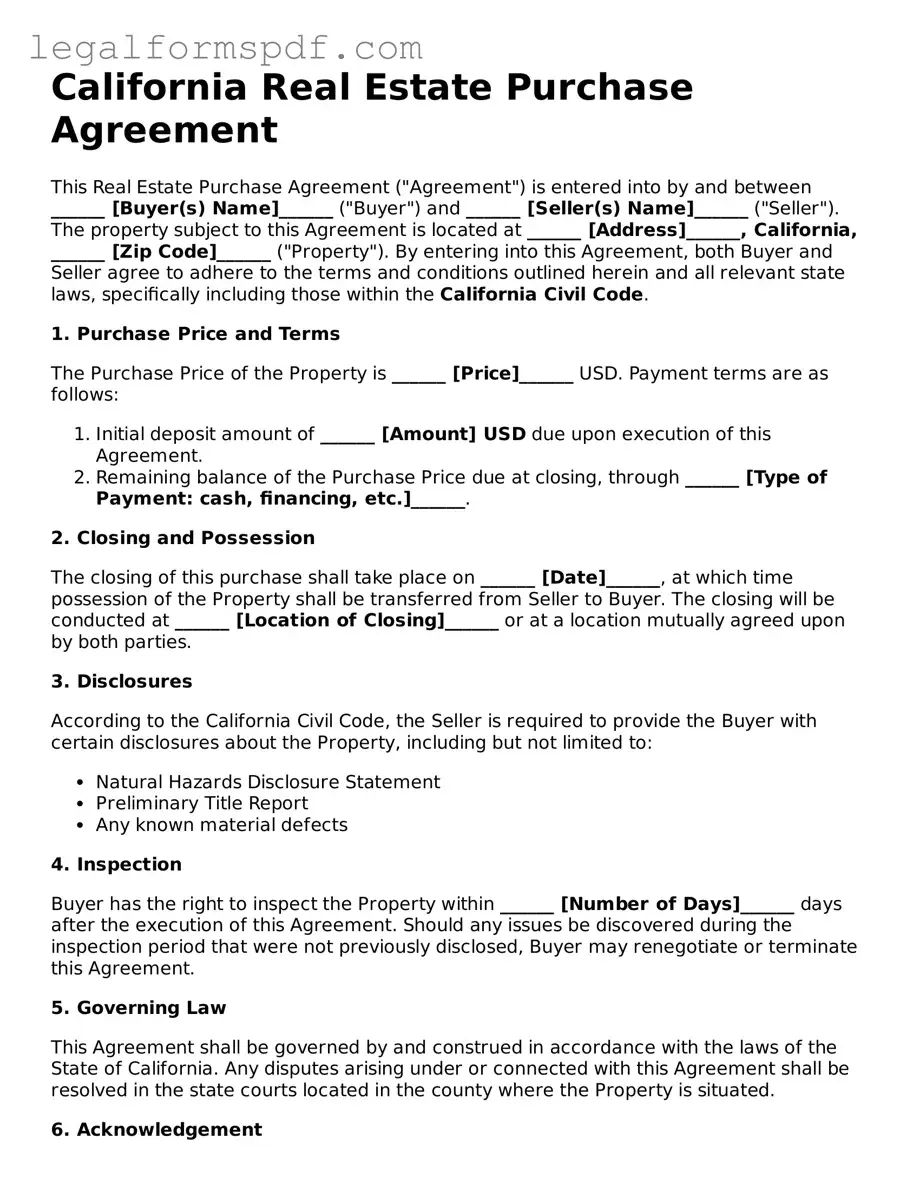The Residential Lease Agreement shares similarities with the California Real Estate Purchase Agreement in their foundational aim to delineate the rights and responsibilities of each party involved in a real estate transaction. Both documents lay out terms such as payment schedules, property details, and the obligations each party must uphold. However, a lease agreement specifically focuses on the rental of property, detailing terms including rent amounts, security deposits, and lease duration, whereas a purchase agreement outlines the conditions under which property ownership is transferred.
A Bill of Sale closely mirrors the structure and purpose of the Real Estate Purchase Agreement by acting as a formal document that records the transfer of ownership of an asset from one party to another. The primary similarity lies in their function to ensure a legal and verifiable transfer of property. While a bill of sale is commonly used for personal property such as cars and boats, a real estate purchase agreement specifically deals with the sale and transfer of real estate.
The Land Contract is another document that bears resemblance to the California Real Estate Purchase Agreement, as both are involved in the process of buying and selling real estate. A land contract, however, is a form of seller financing where the seller retains the title to the property until the buyer completes all payment installments. Like the purchase agreement, it spells out the sale price, property description, and payment terms, but it serves additionally as a financing agreement between the buyer and seller.
An Earnest Money Agreement has parallels with the Real Estate Purchase Agreement because both involve the initial stages of a real estate transaction. This document specifics the earnest money deposit that a buyer offers as a sign of good faith when making an offer on a property. The Real Estate Purchase Agreement typically references this deposit and includes it as part of the overall financial terms. Although serving different purposes, both documents play crucial roles in securing and finalizing real estate transactions.
The Property Disclosure Statement aligns with the California Real Estate Purchase Agreement by addressing the condition and details of the property being sold. This statement requires sellers to disclose known issues or defects that could affect the property's value or desirability. While the Real Estate Purchase Agreement encompasses the terms of the sale, the Property Disclosure Statement focuses on ensuring that the buyer is fully informed about the property's condition before the sale is finalized.
The Title Insurance Commitment bears resemblance to the Real Estate Purchase Agreement in that both are integral to the process of transferring ownership of real estate. The Title Insurance Commitment provides details about what a title insurance policy will cover once issued, including any exclusions or exceptions. This commitment is often a condition within the Real Estate Purchase Agreement, signifying the importance of protecting the buyer from future title disputes and ensuring clear ownership.
An Option to Purchase Agreement is likened to the California Real Estate Purchase Agreement as both documents pertain to the potential sale of property. This agreement grants the buyer the exclusive right to purchase the property at a predetermined price within a certain time frame but does not obligate the buyer to proceed. While it primarily serves to secure the buyer's right to buy, the Real Estate Purchase Agreement finalizes the terms under which the property will be sold if the option is exercised.
The Deed of Trust is comparable to the Real Estate Purchase Agreement in that it is used in real estate transactions, specifically in securing a mortgage loan. This document involves three parties: the borrower, the lender, and the trustee, and it holds the property as collateral for the loan. Whereas the purchase agreement outlines the agreement to sell and buy property, the Deed of Trust concerns the financing aspect and the legal structure for securing the property until the loan is repaid.
A Homeowners Association (HOA) Agreement shares common ground with the California Real Estate Purchase Agreement in terms of regulating the use and responsibilities of property ownership within a community. This agreement sets forth the rules, regulations, and fees associated with living in an HOA-governed community. When purchasing property within such a community, the purchase agreement often references and is contingent upon agreement to the HOA's terms, linking the two documents in the transaction process.
The Mortgage Agreement is closely aligned with the Real Estate Purchase Agreement by its involvement in financing the purchase of property. This legal document outlines the terms of the mortgage loan, including interest rates, repayment schedule, and the rights of the lender in case of default. While the purchase agreement secures the terms of the sale, the Mortgage Agreement secures the terms of the loan used to finance that sale, making them complementary pieces of the real estate transaction puzzle.
